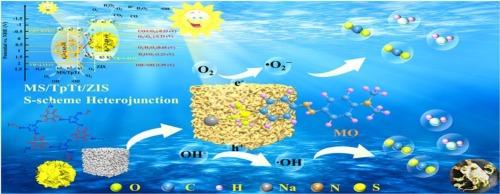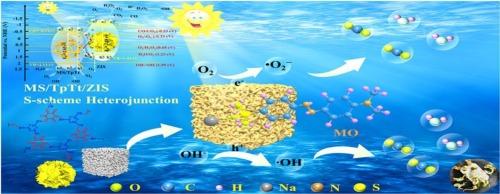可见光驱动三元S-scheme三聚氰胺海绵MS/TpTt/ZIS异质结光催化剂的构建
IF 6.5
1区 化学
Q2 CHEMISTRY, PHYSICAL
引用次数: 0
摘要
电荷分离是提高光催化性能的关键。但单个半导体无法实现有效的电荷分离和输运。以三聚氰胺泡沫(MS)为载体的研究很少。本文采用溶剂热法成功合成了以MS为载体的异质结MS/TpTt/ZnIn2S4-x% (MTZIS-x%)光催化材料。发现MTZIS-3对MO的降解率 %可达近100 %,生物毒性试验表明,降解后的MO残液几乎无生物毒性。MTZIS-3的上催化析氢速率 %达到11523.64 µmol g−1h−1,分别是ZIS、MS/TpTt和COF-TpTt的7.02、11.91和13.19倍。光还原CO2到CO的演化速率为501.55 µmol g−1 h−1。优异的光催化性能是由于s型能带结构有效地促进了电子-空穴的分离,并保留了高度还原的电子。本研究为以质谱为载体构建高效新型异质结光催化剂提供了理论参考。本文章由计算机程序翻译,如有差异,请以英文原文为准。


Construction of visible light-driven ternary S-scheme melamine sponge MS/TpTt/ZIS heterojunction photocatalysts for enhanced photocatalytic pollutant removal and hydrogen evolution
Charge separation critical for improving photocatalytic performance. But single semiconductor cannot realize efficient charge separation and transport. Little research has been reported on using melamine foam (MS) as a carrier. Herein, we have successfully synthesized a heterojunction MS/TpTt/ZnIn2S4-x% (MTZIS-x%) photocatalysis with MS as the carrier by solvothermal method. It was found the degradation rate of MO over MTZIS-3 % could reach almost 100 %, and the biotoxicity tests showed that degraded residual liquid of MO was almost non-biological toxicity. Moreover, the ptotocatalytic H2 evolution rate of MTZIS-3 % reached to 11523.64 µmol g−1h−1, which was 7.02, 11.91 and 13.19 times than that of ZIS, MS/TpTt and COF-TpTt. And the evolution rate of photoreduction CO2 to CO was 501.55 µmol g−1 h−1. The excellent photocatalytic property was owing to the S-scheme band structure facilitated the separation of electron-hole efficiently and retained the highly reducing electrons. This work provided a theoretical reference for the construction of efficient new heterojunction photocatalysts using MS as a carrier.
求助全文
通过发布文献求助,成功后即可免费获取论文全文。
去求助
来源期刊

Journal of Catalysis
工程技术-工程:化工
CiteScore
12.30
自引率
5.50%
发文量
447
审稿时长
31 days
期刊介绍:
The Journal of Catalysis publishes scholarly articles on both heterogeneous and homogeneous catalysis, covering a wide range of chemical transformations. These include various types of catalysis, such as those mediated by photons, plasmons, and electrons. The focus of the studies is to understand the relationship between catalytic function and the underlying chemical properties of surfaces and metal complexes.
The articles in the journal offer innovative concepts and explore the synthesis and kinetics of inorganic solids and homogeneous complexes. Furthermore, they discuss spectroscopic techniques for characterizing catalysts, investigate the interaction of probes and reacting species with catalysts, and employ theoretical methods.
The research presented in the journal should have direct relevance to the field of catalytic processes, addressing either fundamental aspects or applications of catalysis.
 求助内容:
求助内容: 应助结果提醒方式:
应助结果提醒方式:


